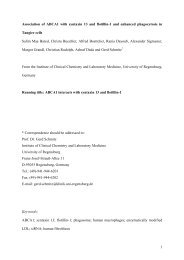SUNDAY, DECEMBER 4- Late Abstracts 1 - Molecular Biology of the ...
SUNDAY, DECEMBER 4- Late Abstracts 1 - Molecular Biology of the ...
SUNDAY, DECEMBER 4- Late Abstracts 1 - Molecular Biology of the ...
You also want an ePaper? Increase the reach of your titles
YUMPU automatically turns print PDFs into web optimized ePapers that Google loves.
<strong>SUNDAY</strong><br />
ei<strong>the</strong>r heregulin or forskolin. The molecular mechanisms that mediate <strong>the</strong> proliferation <strong>of</strong><br />
Schwann cells in response to heregulin and forskolin are not well known. This study was<br />
undertaken to identify <strong>the</strong> role <strong>of</strong> <strong>the</strong> cyclic AMP protein kinase A signaling pathway in Schwann<br />
cells that are cultured with heregulin and forskolin. Studies conducted previously have shown<br />
that <strong>the</strong> A-Kinase anchoring proteins <strong>of</strong> <strong>the</strong> cAMP/PKA pathway play an important role in<br />
Schwann cell division. Incubation <strong>of</strong> neonatal rat Schwann cells with SiRNA oligos syn<strong>the</strong>sized<br />
against AKAP95 and AKAP150 resulted in a reduction in protein levels <strong>of</strong> both AKAPs<br />
accompanied by a decrease in cell proliferation. In addition to a decrease in AKAP protein<br />
levels, Schwann cells cultured with <strong>the</strong> SiRNA oligos against AKAP95 and AKAP150, exhibited<br />
a reduction in protein levels <strong>of</strong> cyclin D3 and PKB/Akt respectively. To investigate if <strong>the</strong> loss <strong>of</strong><br />
AKAPs along with cyclin D3 occurred at <strong>the</strong> level <strong>of</strong> syn<strong>the</strong>sis or degradation, neonatal rat<br />
Schwann cells were cultured with <strong>the</strong> protein syn<strong>the</strong>sis inhibitor cycloheximide and <strong>the</strong><br />
proteasome inhibitor lactacystin. Immunoblot analysis <strong>of</strong> Schwann cells incubated with<br />
cycloheximide and SiRNA oligos or cycloheximide alone showed a reduction in both AKAP95<br />
and cyclin D3 levels. Schwann cells cultured with lactacystin and SiRNA oligos showed a<br />
marked reduction in AKAP95 and cyclin D3 levels in comparison to cultures incubated with<br />
lactacystin only. These preliminary observations suggests that <strong>the</strong> loss <strong>of</strong> AKAP95 along with<br />
<strong>the</strong> cyclin D3 proteins does not occur at <strong>the</strong> syn<strong>the</strong>sis or degradation levels and instead may be<br />
mediated by a different mechanism. To examine if AKAP150 associates with PKB/Akt to<br />
stimulate Schwann cell proliferation, cells were incubated with modified N2 media or modified N2<br />
media with heregulin and forskolin. Using immun<strong>of</strong>luorescent staining techniques, preliminary<br />
results demonstrate that Schwann cells treated with heregulin and forskolin exhibit distinct<br />
colocalization patterns for AKAP150 and PKB/Akt. These results suggest that in <strong>the</strong> presence <strong>of</strong><br />
forskolin and heregulin, AKAP150 may associate with PKB/Akt to mediate cell proliferation.<br />
2029<br />
Turn motif phosphorylation negatively regulates activation-loop phosphorylation in Akt.<br />
D. Hiraoka 1 , E. Okumura 1 , T. Kishimoto 1 ; 1 Tokyo Institute <strong>of</strong> Technology, Yokohama,<br />
Kanagawa, Japan<br />
Akt, also known as PKB, plays a central role in various signaling pathways that regulate cellular<br />
processes such as metabolism, proliferation and survival. Under stimulation, phosphorylation <strong>of</strong><br />
<strong>the</strong> activation loop (A-loop) and hydrophobic motif (HM) <strong>of</strong> Akt by <strong>the</strong> kinase, PDK1, and <strong>the</strong><br />
mammalian target <strong>of</strong> rapamycin complex 2 (mTORC2), respectively, results in its activation. A<br />
well-conserved threonine in <strong>the</strong> turn motif (TM) is also constitutively phosphorylated by<br />
mTORC2 and contributes to <strong>the</strong> stability <strong>of</strong> Akt. However, <strong>the</strong> relationship between TM<br />
phosphorylation and <strong>the</strong> phosphorylation <strong>of</strong> Akt on <strong>the</strong> HM and A-loop has not been sufficiently<br />
evaluated. Using starfish oocytes as a model system, our study provides <strong>the</strong> first evidence that<br />
TM phosphorylation plays a negative role in A-loop phosphorylation. In this system, <strong>the</strong><br />
maturation-inducing hormone, 1-methyladenine, stimulates Akt to induce meiotic reinitiation<br />
through <strong>the</strong> activation <strong>of</strong> cyclin B-Cdc2. The phosphorylation status <strong>of</strong> Akt was monitored via<br />
introduction <strong>of</strong> exogenous human Akt in starfish oocytes. Injection <strong>of</strong> an anti-starfish TOR<br />
antibody inhibited TM and HM phosphorylation, suggesting that phosphorylation <strong>of</strong> <strong>the</strong>se sites<br />
depends on TOR, as reported in mammalian cells. Precise analyses <strong>of</strong> single or double alanine<br />
substitution mutants at each <strong>of</strong> three phosphorylation residues revealed that TM<br />
phosphorylation renders Akt susceptible to dephosphorylation on <strong>the</strong> A-loop. When A-loop<br />
phosphatase was inhibited by okadaic acid, TM phosphorylation still reduced A-loop<br />
phosphorylation, suggesting that <strong>the</strong> effect is caused at least partially through reduction <strong>of</strong><br />
sensitivity to PDK1. By contrast, HM phosphorylation enhanced A-loop phosphorylation and<br />
achieved full activation <strong>of</strong> Akt via a mechanism at least partially independent <strong>of</strong> TM
















